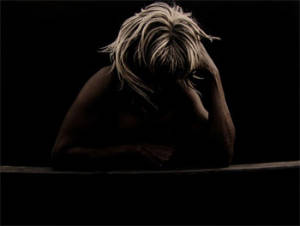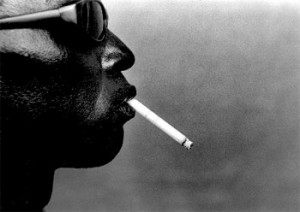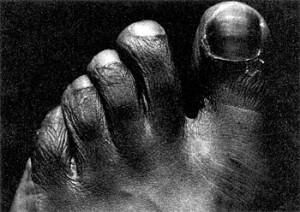Labeling the Work of Cuba’s Rene Peña
María Matienzo Puerto

HAVANA TIMES, Oct. 6 — When meeting René Peña for the first time, the initial impression is always that of aggressiveness. Later, you find a sensitivity sui generis that isn’t meant to charm and that only non-prejudiced eyes can distinguish: passing beyond the spectacle of his strong gestures, his marking of the territory, the macho-tinged compliments, to note at last his sincere gaze and sensual movements.
His language might seem vulgar to some puritan souls, but we can also note the artist who doesn’t need a camera slung around his neck to be identified. His images seek another dimension to beauty, one that lacerates and questions. Nonetheless, this is what some of us conceive of as art.
I have let this interview mature over a four year period, as we do with wine, to allow it to develop a deeper flavor. Perhaps I have achieved my objective: his words are still acidic, reflecting a certain bitterness at the racism and cowardice that are still very much with us. To understand his works, the critics should converse with him first.
HT: Tell me – what made you decide to become a photographer?
Rene Peña: I had never thought about being an artist, nor did I have any idea what that was. The first thing I did within what they call the world of art was to study music for four years at the Cartula conservatory, because I liked the violin. I wasn’t thinking about about becoming famous – I’m speaking about myself at eight or nine years old. I found out there that I wasn’t a good musician, and I dropped out.

After that I learned to play guitar, and I joined my friends who were playing in a rock group. Later, while I was on at the boarding school in the countryside program I began to study painting from a collection of books on perspective, charcoal, water colors, etc., but I was terrible at this as well, and I didn’t feel fulfilled. At the same time, I was taking photos of my companions on the beach with scant interest; until finally I found a book that talked about photography and about expressing yourself through photography.
HT: Is the theme of blackness among those that disgust you?
Rene Peña: No, I adore it, but in my works I’ve chosen to look at it from the opposite direction. I’ve always thought about it, and since I was eleven I’ve read about issues regarding racism. Also, of course, I’m living it. I was born in 1957, and I saw true racism. Not the racism that everyone talks about, as in “I went to look for work but no one gave me a job”. That racism can be disguised. They didn’t give you the job because you’re not trained, and you are wrapping yourself in the flag of your blackness to say that they didn’t give you work.
No, I’m talking about going out walking with my wife and just in front of me is a white woman of about 70 with her two grandchildren, and since we were walking at a faster pace, the woman moved aside to let us pass and one of the grandchildren asked her, “Why did you move aside for them if they’re black?” And I’m talking about 1990.
People then began telling me that they saw in my work an artist whose work focuses on the blacks. This, even though I am doing shots of interiors – the house where I lived, the homes of my friends. If I’m a black person and I was born in Buena Vista – what houses am I going to photograph? The same houses that the directors of soap operas are filming?

Those same people began to say that my photos were about themes of the past, because everyday people appeared in them. Afterwards, they painted me as a cruel black person because I used myself as a subject to speak of things that have nothing to do with racial matters, but with social matters which is what interests me most.
So, I discovered that many people were annoyed at this type of photography. The reality is that the ingredient of blackness that everyone sees or points out is more to be found in my verbal discourse than in the photos.
And I keep doing whatever I want with the photography: speaking about issues that interest me; working with the same black subject, and not because his skin is black but because if I need someone with a shaven head, I look first at those who are close to me and once again it’s someone black who appears. But with respect to this, I don’t hold any prejudices because at times I need a white person, and I look for one. Like when I was looking for a forearm in which you could see the veins and my neighbor offered her hand.
That’s what’s going on with me and this business of blackness. Imagine, a guy like me proud of being black in a country where that isn’t seen as any kind of a virtue. It doesn’t make any sense that those things happen, it has no logic.
HT: The same talk about blackness is a strong theme among rap musicians. What do you think of the viewpoints they put forward?

Rene Peña: I don’t pay a lot of attention to them. What I don’t like about Rap is that its consumers are the same black people. If I’m going to use it as a tool so that other people become aware of what’s going on, then I should look for a medium that those other people consume, not one that I myself consume. It’s like discussing the theme amongst ourselves. So when we have at hand a white person with a certain degree of power to whom we could explain what’s been happening so that they do something or just become aware of it, we don’t do it.
HT: Another controversial theme in your work has been eroticism.
Rene Peña: What is seen at times is the product of a camera on a tripod, my body dancing and the camera taking pictures everywhere. If a degree of sensuality emerges from that, what are we going to do?
Let me explain this, piece by piece. I am not exploiting the theme of homoeroticism, as has been bandied around. We live in a world where there are maybe only three people with sufficient criteria to talk. And since we’re surrounded by more people without sufficient criteria, the only thing they do is to grab onto someone else’s words and make them their own. Without even including the fact that having some criteria doesn’t mean that you are correct.
One of my proposals is to try and make impossible the use of labels that reflect only those who make them, or the obsession that some have to hold onto a phrase so that when they talk they have something to quote. In this artistic world it has become more important to be quoted than it is to say something intelligent. Because of this, we have all the fuss about patents and rights. Everyone wants to get a patent to secure their rights, meaning the part about money.
There’s a word that’s something like “labeling”, but that I can’t recall. I’m also trying to put a name on it. You know, every time we see something that we can’t explain with the knowledge we have, we change it into a fantasy.

It does seem to me a good thing that people want to know what’s going on, and what the new phenomenon is called. But everything depends on the base of knowledge that they have to explain it with.
HT: Perhaps that has to do with a fears some have of being the first to speak the truth, and a certain degree of panic about the consequences?
Rene Peña: When I was young, I was very cowardly. I was afraid of the dark, of coconut trees, of a neighbor called Conga because she was a black woman who was dark, skinny, hunch-backed and had some bracelets that clanked: a very good person, but she looked like a witch. And this fear was a kind of pleasure.
For that reason, I believe that the fear that you refer to within this world of art is a thing that we enjoy, to the point that I know of people who want to hear what they didn’t have the courage to say themselves, to have the nerve to condemn it. Sometimes it’s a pleasure to be listening through keyholes. Cowards also can vacillate with their cowardice.
HT: All of your answers have touched on the tools for the exercise of criticism. What’s your position on this?
Rene Peña: Everybody explains what they know, and if they don’t have any basic knowledge they copy it. I’m talking about knowledge, not wisdom which should be another tool of criticism. So what happens with an artist’s body of work? People see it, try to understand it. If the artist is figurative and paints inert nature or portraits of well-recognized people, then they don’t have to try and find anything else in that ocean that is art. People will say. “Hey look, I got it just as it is”, even though you can’t see the hands of the subject.
But if suddenly you have no way of understanding what you’re seeing, then there are very different criteria. “Brother, aren’t these people messed up! Do you know what it means to call this art?” That’s the case of a few years ago in Lam, when we watched a Canadian woman dance on a stage. There are those who made fun and assured that they could do the same thing; that’s one possibility. The other possibility when we don’t understand is that we try to get to know the artist: try to know who they are, what their name is, where they live, what artistic movement they belong to and what their sexual inclination is. And then we simply cast aside the work, which is the most important, and substitute the person.

This happens about 90% of the time in contemporary art and it’s a given why you don’t understand the work. Contemporary art depends a lot on knowledge that you have acquired beforehand.
Very few critics actually write a critique without having done an interview beforehand. They aren’t capable of entering into the work of art and taking that as a starting point for their writing. First they visit the artist and later venture to write an article about whatever occurs to them. This is then read by a half million people who use it as a guide to understanding the artist; a half million people including the artist who is laughing because he knows that the writer hasn’t invested anything as a critic.
Instead, critics are trained in how to convert a text into something pleasant to read, how to do it according to the fashion, using the expressions that are currently in vogue in the world, the tendencies of the moment. And later they publish it in any Cuban art magazine.
One of the characteristics of my work is that of trying constantly to confuse those who want to understand my works through the author: Why would they want to do that? I try to confuse them all the time – with sexual, physical, social and ethnic matters.
In my case for example, I make crosses with husks and dolls, possibly allusions to the African culture. But who says that just because you do a thing, you have to believe in it? I can talk about anything I want, not only about what I believe in, but also about the things that interest me, that I enjoy, that disgust me, that I try to combat, that I love.
HT: With all of this about “no definitions”, don’t you think that you have gotten a little into the postmodern wave?
Rene Peña: What is this “postmodern” thing? I’m not sure what postmodern is. They’re the same precepts as the modern period or those of the vanguard in the 50’s or 60’s. That’s when they began to develop a kind of art where one of the things to accomplish was the ephemeral, to do something that wouldn’t be assimilated into the marketplace.
This appeared again in the postmodern era. Now they don’t use the same words, but it’s about no authority over the work of the artist. And all of that is a lie. Those that promote it don’t believe anything about it. Postmodernism is also ambivalence. It doesn’t want to have a label, and now it already has one.
Originally published in Spanish by Esquife.cult.cu






I love this artist.